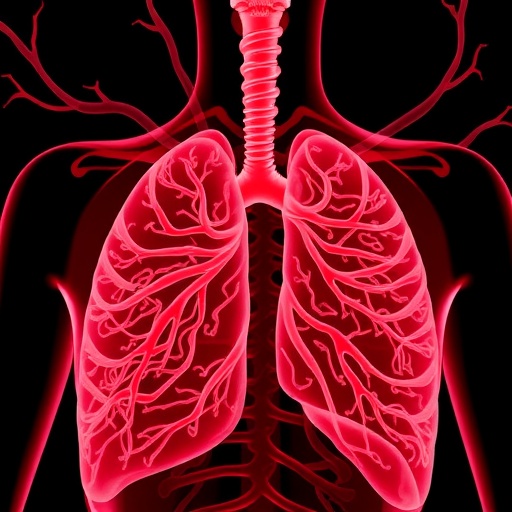In the ever-evolving landscape of pediatric respiratory diseases, a newly detailed condition termed lymphatic plastic bronchitis has emerged at the forefront of medical research. In a groundbreaking study led by Cheng, BL., Xu, D., Wu, XL., and colleagues, published in the World Journal of Pediatrics in 2025, this enigmatic syndrome is explored with unprecedented depth, revealing both its underlying pathophysiology and clinical implications. This research not only sheds light on a previously obscure disease but also underscores the critical role of the lymphatic system in respiratory health and disease.
Lymphatic plastic bronchitis represents a fascinating intersection of respiratory pathology and lymphatic system dysfunction. Characterized predominantly by the formation of rubbery, branching bronchial casts composed of lymphatic fluid and cellular debris, this disorder leads to airway obstruction and severe respiratory compromise in affected pediatric patients. The study by Cheng and colleagues meticulously describes the morphological and functional aberrations in the lymphatic system that precipitate these obstructive bronchial casts.
At the core of lymphatic plastic bronchitis lies an intricate disruption of normal lymphatic drainage within the pulmonary system. The lymphatic vessels, typically responsible for draining interstitial fluid and maintaining immune homeostasis, exhibit abnormal dilation and leakage in this condition. This pathological lymphatic reflux results in the extravasation of lymph into the bronchial tree, promoting the formation of tenacious mucus plugs that occlude airways and impair ventilation.
The research utilizes advanced imaging modalities, including dynamic contrast-enhanced magnetic resonance lymphangiography, to visualize the lymphatic anatomy and aberrations with remarkable clarity. Such imaging has revealed distinctive patterns of lymphatic channel dilation and abnormal lymph flow, providing both diagnostic and prognostic insights. By mapping these lymphatic disruptions, the study advances understanding of disease extent and guides targeted therapeutic interventions.
Importantly, the clinical manifestations of lymphatic plastic bronchitis extend beyond mere airway obstruction. Patients frequently present with persistent cough, wheezing, and recurrent episodes of respiratory distress, often leading to progressive hypoxemia. Conventional treatments for similar respiratory ailments, such as corticosteroids and bronchodilators, have shown limited efficacy in these cases due to the unique lymphatic origin of the pathology.
Therapeutic approaches discussed in the study involve a combination of interventional radiology, pharmacologic therapy, and supportive care. Notably, selective lymphatic embolization, aimed at occluding aberrant lymphatic channels, emerges as a promising treatment avenue. This minimally invasive procedure targets the primary source of lymph leakage, thereby reducing the formation of bronchial casts and improving respiratory function.
The authors highlight the importance of early diagnosis and intervention to prevent irreversible lung damage and chronic respiratory failure. They advocate for heightened clinical suspicion in pediatric patients with intractable respiratory symptoms unresponsive to standard management, particularly when imaging demonstrates lymphatic abnormalities. Such vigilance is crucial to optimize outcomes in this vulnerable population.
From an immunologic standpoint, the study delves into the role of lymph fluid constituents in exacerbating airway inflammation. The bronchial casts comprised predominantly of lymph with immune cells and proteins contribute to ongoing local inflammation and tissue remodeling, which may perpetuate airway hyperreactivity and fibrosis if untreated.
This research also opens new avenues for exploring the molecular mechanisms governing lymphatic vessel integrity and function in pediatric respiratory diseases. Understanding the regulatory pathways involved in lymphangiogenesis and lymphatic permeability could unveil novel therapeutic targets, potentially applicable to a broader spectrum of lymphatic disorders beyond plastic bronchitis.
While lymphatic plastic bronchitis remains rare, its identification underscores the necessity of multidisciplinary collaboration encompassing pulmonologists, radiologists, immunologists, and interventional specialists. Such collaboration is vital for comprehensive patient care, from accurate diagnosis through tailored treatment strategies, emphasizing personalized medicine within pediatric pulmonology.
The study further sparks interest in potential genetic and environmental factors influencing lymphatic vessel development and susceptibility to such lymphatic derangements. Future research is poised to investigate these aspects, aiming to identify high-risk individuals and possibly institute preventive measures.
A significant contribution of this journal article lies in the detailed histopathological analyses presented. Bronchial cast biopsies reveal complex cellular compositions and structural characteristics that not only facilitate diagnosis but also deepen understanding of the disease’s pathogenesis. These findings may inform the development of novel biomarkers for early detection and monitoring.
The implications of this research resonate beyond clinical realms, calling for enhanced educational efforts to raise awareness among healthcare providers regarding this unusual bronchial pathology. Increased dissemination of knowledge about lymphatic plastic bronchitis could lead to earlier recognition, reducing diagnostic delays and improving prognosis.
As pediatric respiratory diseases continue to challenge the medical community, the elucidation of lymphatic plastic bronchitis embodies a pivotal advancement. It reminds us that the lungs’ health is intricately linked to the lymphatic system’s function, and disturbances in this network can precipitate complex, life-threatening conditions requiring sophisticated diagnostic and therapeutic techniques.
In conclusion, the work of Cheng, Xu, Wu, and their teammates marks a significant milestone in respiratory medicine by defining lymphatic plastic bronchitis and charting a path toward effective management. Their research not only demystifies a complicated clinical syndrome but also enhances the broader understanding of lymphatic involvement in respiratory diseases, paving the way for innovative treatments and better patient outcomes in the foreseeable future.
Subject of Research: Lymphatic plastic bronchitis, a pediatric respiratory disorder involving lymphatic system dysfunction causing bronchial cast formation.
Article Title: Lymphatic plastic bronchitis
Article References:
Cheng, BL., Xu, D., Wu, XL. et al. Lymphatic plastic bronchitis. World J Pediatr (2025). https://doi.org/10.1007/s12519-025-00982-8
Image Credits: AI Generated




